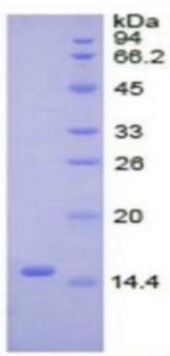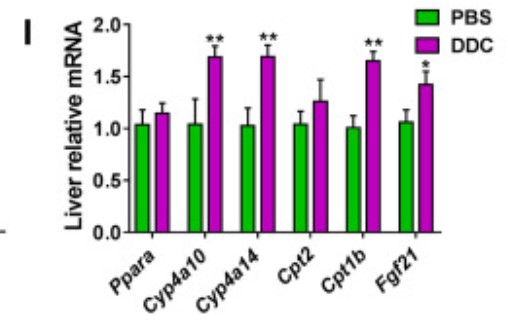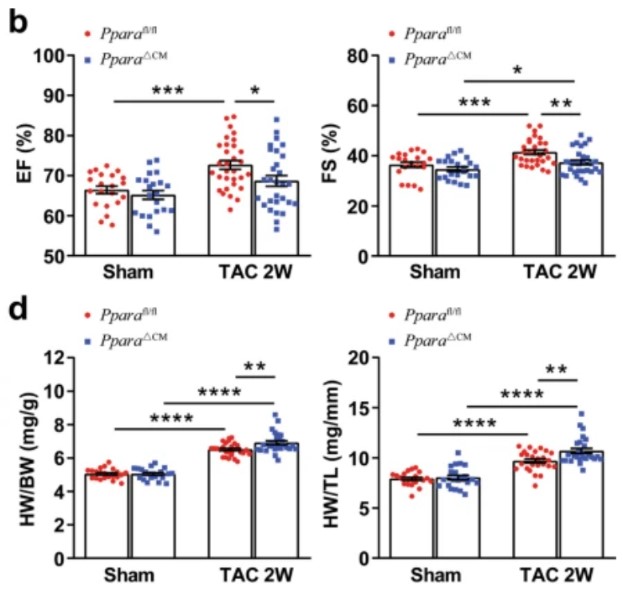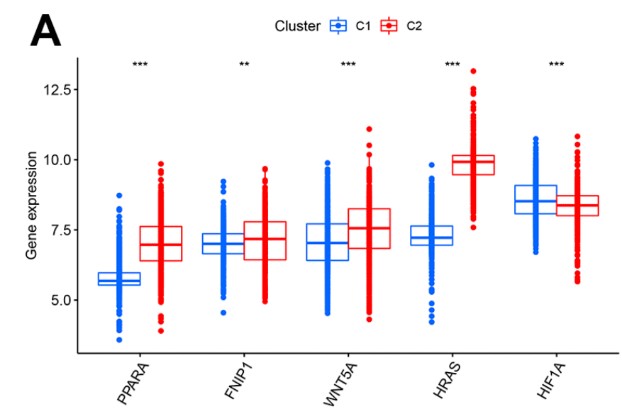PPARA
-
Official Full Name
peroxisome proliferator-activated receptor alpha
-
Overview
Peroxisome proliferators include hypolipidemic drugs, herbicides, leukotriene antagonists, and plasticizers; this term arises because they induce an increase in the size and number of peroxisomes. Peroxisomes are subcellular organelles found in plants and animals that contain enzymes for respiration and for cholesterol and lipid metabolism. The action of peroxisome proliferators is thought to be mediated via specific receptors, called PPARs, which belong to the steroid hormone receptor superfamily. PPARs affect the expression of target genes involved in cell proliferation, cell differentiation and in immune and inflammation responses. Three closely related subtypes (alpha, beta/delta, and gamma) have been identified. This gene encodes the subtype PPAR-alpha, which is a nuclear transcription factor. Multiple alternatively spliced transcript variants have been described for this gene, although the full-length nature of only two has been determined. -
Synonyms
PPARA; peroxisome proliferator-activated receptor alpha; peroxisome proliferative activated receptor, alpha , PPAR; hPPAR; NR1C1; MGC2237; MGC2452; Nuclear receptor subfamily 1 group C member 1; OTTHUMP00000197740; OTTHUMP00000197741; Peroxisome proliferator activated receptor alpha; PPAR; PPAR-alpha; PPARA_HUMAN; PPARalpha; peroxisome proliferative activated receptor, alpha; peroxisome proliferator-activated nuclear receptor alpha var;
- Recombinant Proteins
- Cell & Tissue Lysates
- Protein Pre-coupled Magnetic Beads
- Chicken
- Human
- Mouse
- Rat
- Rhesus Macaque
- E. coli
- E.coli
- HEK293
- Insect Cell
- Mammalian Cell
- Sf9 Insect Cell
- C
- His
- GST
- His (Fc)
- Avi
- Myc
- His|MBP
- N/A
- N
- Background
- Quality Guarantee
- Case Study
- Involved Pathway
- Protein Function
- Interacting Protein
- PPARA Related Articles
- PPARA Related Research Area
What is ppara protein?
PPARA protein, also known as Peroxisome Proliferator-Activated Receptor Alpha, is a transcription factor that plays a crucial role in the regulation of lipid metabolism and energy homeostasis. PPARA is primarily expressed in tissues that exhibit high rates of fatty acid oxidation, such as the liver, heart, and skeletal muscle.
What is the function of ppara protein?
The function of PPARA protein is to regulate the expression of genes involved in lipid metabolism, fatty acid oxidation, and inflammation. It forms heterodimers with the retinoid X receptor (RXR) and binds to specific DNA sequences called peroxisome proliferator response elements (PPREs) in the promoter regions of target genes. This binding activates or represses the transcription of these target genes, thereby modulating lipid metabolism and energy balance.
Ppara related signaling pathway
The PPARA signaling pathway involves the activation of PPARA by binding to specific ligands and subsequent regulation of target gene expression. When activated, PPARA forms a heterodimer with retinoid X receptor (RXR), which then binds to specific DNA sequences called peroxisome proliferator response elements (PPREs) within the promoter regions of target genes. This binding leads to the transcriptional regulation of genes involved in fatty acid oxidation, lipoprotein metabolism, glucose metabolism, and inflammation.
Ppara Related Diseases
- Dyslipidemia: Ppara plays a key role in regulating lipid metabolism, including the metabolism of fatty acids and triglycerides. Dysregulation of Ppara signaling can lead to abnormal lipid levels, such as elevated levels of triglycerides and low-density lipoprotein cholesterol, which are risk factors for cardiovascular diseases.
- Non-alcoholic fatty liver disease (NAFLD): Ppara activation promotes fatty acid oxidation in the liver, helping to prevent the accumulation of fat. In NAFLD, Ppara signaling is impaired, leading to excessive fat buildup in the liver and the development of liver inflammation and fibrosis.
- Diabetes: Ppara is involved in glucose homeostasis and insulin sensitivity. Impairment of Ppara signaling can lead to insulin resistance, impaired glucose metabolism, and the development of type 2 diabetes
- Dyslipidemia: PPARA agonists, also known as fibrates, are used clinically to treat dyslipidemia, a condition characterized by abnormal lipid levels in the blood. Activation of PPARA promotes the breakdown of fatty acids and reduces triglyceride and cholesterol levels, leading to improved lipid profiles.
- Non-alcoholic fatty liver disease (NAFLD): NAFLD is a condition characterized by abnormal accumulation of fat in the liver, often associated with obesity, insulin resistance, and dyslipidemia. PPARA activation can enhance fatty acid oxidation and reduce hepatic steatosis, making it a potential therapeutic strategy for NAFLD.
Biomedical Application of ppara Protein
- Dyslipidemia: PPARA agonists, also known as fibrates, are used clinically to treat dyslipidemia, a condition characterized by abnormal lipid levels in the blood. Activation of PPARA promotes the breakdown of fatty acids and reduces triglyceride and cholesterol levels, leading to improved lipid profiles.
- Metabolic syndrome: PPARA activation can help improve insulin sensitivity, lower blood glucose levels, and attenuate systemic inflammation, making it a potential therapeutic target for metabolic syndrome. Several studies have investigated PPARA agonists in the management of metabolic syndrome and its associated complications.
- Non-alcoholic fatty liver disease (NAFLD): NAFLD is a condition characterized by abnormal accumulation of fat in the liver, often associated with obesity, insulin resistance, and dyslipidemia. PPARA activation can enhance fatty acid oxidation and reduce hepatic steatosis, making it a potential therapeutic strategy for NAFLD.
High Purity

Fig1. SDS-PAGE (PPARA-1066H)

(Youbo Zhang, 2022)
Fig2. CYP2E1 antagonist alleviates high-fat diet-induced obesity via PPARα–FGF21–beige axis. Hepatic mRNA expression of PPARα target genes.

(Xia Wang, 2021)
Fig3. Pparafl/fl and PparaΔCM mice were subjected to TAC or sham surgery for 2 weeks. a Representative two-dimensional guided M-mode echocardiogram of the left ventricle. b Quantification of ejection fraction (EF%) and fractional shortening (FS%). d Heart weight/body weight (HW/BW) ratios and heart weight/tibial length (HW/TL) ratios

(Hao Zhang, 2023)
Fig4. Comprehensive analysis between different clusters. (A) The expression level of WNT5A, FNIP1, PPARA, HRAS, HIF1A.
PPARA involved in several pathways and played different roles in them. We selected most pathways PPARA participated on our site, such as PPAR signaling pathway, cAMP signaling pathway, Adipocytokine signaling pathway, which may be useful for your reference. Also, other proteins which involved in the same pathway with PPARA were listed below. Creative BioMart supplied nearly all the proteins listed, you can search them on our site.
| Pathway Name | Pathway Related Protein |
|---|---|
| PPAR signaling pathway | MMP1A;PLIN1;CYP4A14;CYP4A12A;CYP4A10;SCD;FABP1;PPARD;ME1 |
| cAMP signaling pathway | GRIA4;HTR6;HCN4;PPARA;PRKACA;VIPR2;PLCE1;PDE3A;MAPK10 |
| Adipocytokine signaling pathway | PRKAA1;PCK2;TNF;LEPA;MAPK9;AKT2;AKT2L;PRKAG2;NFKBIA |
| Insulin resistance | CREB3L3;PYGL;RPS6KA2;PIK3CB;PRKAB1;PIK3R2;PTPN11B;PTPN11;PTPRFB |
| Non-alcoholic fatty liver disease (NAFLD) | SREBF1;NDUFAB1;NDUFC1;RXRA;INSR;PPARA;NDUFS6;INS2;MAP3K5 |
| Hepatitis C | NFKBIA;IKBKB;RNASEL;TNF;CLDN14;IKBKG;Ifna15;CLDN23;IFNA6 |
PPARA has several biochemical functions, for example, DNA binding, MDM2/MDM4 family protein binding, NFAT protein binding. Some of the functions are cooperated with other proteins, some of the functions could acted by PPARA itself. We selected most functions PPARA had, and list some proteins which have the same functions with PPARA. You can find most of the proteins on our site.
| Function | Related Protein |
|---|---|
| DNA binding | NKX2.2A;RAG2;BTBD11A;PAX2A;THAP3;ZFP521;VEZF1;MEIS1B;OTPB |
| MDM2/MDM4 family protein binding | CAV1;CDKN2A;PPARA;RFWD3;CDK5RAP3;TRP53;PSME3 |
| NFAT protein binding | MAPK14;SPI1;PPARA;FOXP3;SFPI1;GATA4 |
| RNA polymerase II core promoter proximal region sequence-specific DNA binding | MYPOP;NFIC;NKX6;SMAD4;ZNF92;TCF12;JUNBA;FOS;BATF2 |
| RNA polymerase II repressing transcription factor binding | STAT3;GATA6;BBS4;MIXL1;BBS5;BBS10;HDAC1;MTA2;BBS2 |
| RNA polymerase II transcription factor activity, ligand-activated sequence-specific DNA binding | RORAA;NR2F1;NR5A1B;NR1H3;NR2E3;RORCA;HNF4A;PPARA;VDRA |
| drug binding | DHFR;PIGC;PPP3CA;PPARA;SLC6A4A;SMO;FOLR1;GRIK1;PPARD |
| lipid binding | SH3GLB1;PPARD;FABP6;SH3GL2;BPIFA3;CHMP4A;YBX2;PCYT1A;PTGS2 |
| phosphatase binding | PPP1R37;CTSC;DLG1;PPP1R35;KIAA0649;ELFN2;CRY2;CHCHD3;SMAD3 |
| protein binding | LRFN2;GSDMD;CD2AP;CYSLTR1;PRSS3;DUSP23;SLC25A4;FAS;SQSTM1 |
| protein complex binding | PGAM5;ING2;SLC27A5;NCOA1;STK11;CYFIP1;MAPK8IP2;FBN1;ITPR1 |
| protein domain specific binding | ICA1L;YWHAG;PPP3R1;ESRRA;SNCA;IPCEF1;GSN;MYO7A;YWHAE1 |
| sequence-specific DNA binding | NKX1.2LB;GATA5;ISL2;FOXK2;RX1;EDF1;DMRT3A;HOXC4;FOXB1 |
| steroid hormone receptor activity | NR2F6B;NR2E3;ESR1;RXRGB;RXRAB;RXRBB;NR2F1A;NR6A1;NR4A2 |
| transcription factor activity, sequence-specific DNA binding | SP1;HOXD3A;AHR;SIX1B;ZKSCAN5;DLX4;PPARG;ZSCAN12;GABPB1 |
| transcriptional activator activity, RNA polymerase II core promoter proximal region sequence-specific binding | HNF4A;TP63;ELK1;GLI3;NFIA;STK16;BARHL2;ZSCAN21;NR1H4 |
| transcriptional activator activity, RNA polymerase II transcription factor binding | MIXL1;JUN;NR1H4;KLF14;CREB1;CLOCK;NKX2;KLF4;NOTCH1 |
| transcriptional repressor activity, RNA polymerase II core promoter proximal region sequence-specific binding | ESRRA;OVOL1;MYPOP;POU4F2;KCNIP3;EN1;ASCL1;ASCL2;NFIL3-5 |
| ubiquitin conjugating enzyme binding | ANKIB1A;RNF144AA;RNF180;DCUN1D1;DCUN1D4;RNF217;DCUN1D5;RNF40;GRIK2 |
| zinc ion binding | FNTB;JADE3;TRIM3B;POLR2L;CA15B;ZFHX3;BMP1A;PCGF1;DUSP12 |
PPARA has direct interactions with proteins and molecules. Those interactions were detected by several methods such as yeast two hybrid, co-IP, pull-down and so on. We selected proteins and molecules interacted with PPARA here. Most of them are supplied by our site. Hope this information will be useful for your research of PPARA.
NCOR2; GRB2; CHD9; NCOR1; PIK3R3; UBE2I; PRMT2; MED1; LAMTOR5; RXRG; FOXA3; CDK3; PRMT1
- Q&As
- Reviews
Q&As (5)
Ask a questionPPARA enhances the breakdown of fatty acids and promotes their oxidation, thereby playing a key role in lipid metabolism.
Yes, fibrates are a class of drugs that act as PPARA agonists and are used to treat conditions such as hyperlipidemia.
Some research suggests that PPARA activation may have neuroprotective effects and could be explored as a therapeutic avenue for neurodegenerative diseases.
PPARA is predominantly expressed in tissues with high energy expenditure, such as the liver, heart, and skeletal muscle.
Yes, PPARA agonists have been investigated as potential therapeutic agents for managing dyslipidemia by promoting lipid metabolism.
Customer Reviews (3)
Write a reviewTheir expertise and responsiveness exemplify their dedication to assisting customers, offering solutions and guidance whenever challenges arise.
The combination of the protein's exceptional characteristics and the manufacturer's outstanding technical assistance equips me with the necessary resources to overcome potential hurdles and achieve groundbreaking results.
Its impressive purity and functional properties make it an ideal choice for my research, ensuring precise and accurate results.
Ask a Question for All PPARA Products
Required fields are marked with *
My Review for All PPARA Products
Required fields are marked with *


